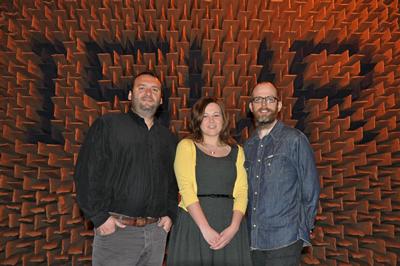New study finds blind people have the potential to use their ‘inner bat’ to locate objects

New research from the University of Southampton has shown that blind and visually impaired people have the potential to use echolocation, similar to that used by bats and dolphins, to determine the location of an object.
The study, which is published in the journal Hearing Research, examined how hearing, and particularly the hearing of echoes, could help blind people with spatial awareness and navigation. The study also examined the possible effects of hearing impairment and how to optimise echolocation ability in order to help improve the independence and quality of life of people with visual impairments.
Researchers from the University of Southampton's Institute of Sound and Vibration Research (ISVR) and University of Cyprus conducted a series of experiments with sighted and blind human listeners, using a ‘virtual auditory space' technique, to investigate the effects of the distance and orientation of a reflective object on ability to identify the right-versus-left position of the object. They used sounds with different bandwidths and durations (from 10-400 milliseconds) as well as various audio manipulations to investigate which aspects of the sounds were important. The virtual auditory space, which was created in ISVR's anechoic chamber, allowed researchers to remove positional clues unrelated to echoes, such as footsteps and the placement of an object, and to manipulate the sounds in ways that wouldn't be possible otherwise (e.g. get rid of the emission and present the echo only).
Dr Daniel Rowan, Lecturer in Audiology in ISVR and lead author of the study, says: "We wanted to determine unambiguously whether blind people, and perhaps even sighted people, can use echoes from an object to determine roughly where the object is located. We also wanted to figure out what factors facilitate and restrict people's abilities to use echoes for this purpose in order to know how to enhance ability in the real world."
The results showed that both sighted and blind people with good hearing, even if completely inexperienced with echolocation, showed the potential to use echoes to tell where objects are. The researchers also found that hearing high-frequency sounds (above 2 kHz) is required for good performance, and so common forms of hearing impairment will probably cause major problems.
Dr Daniel Rowan adds: "Some people are better at this than others, and being blind doesn't automatically confer good echolocation ability, though we don't yet know why. Nevertheless, ability probably gets even better with extensive experience and feedback.
"We also found that our ability to use echoes to locate an object gets rapidly worse with increasing distance from the object, especially when the object is not directly facing us. While our experiments purposely removed any influence of head movement, doing so might help extend ability to farther distances. Furthermore, some echo-producing sounds are better for determining where an object is than others, and the best sounds for locating an object probably aren't the same as for detecting the object or determining what, and how far away, the object is."
The knowledge gained from this study will help researchers to develop training programmes and assistive devices for blind people and sighted people in low-vision situations. The team is also extending their research to investigate finding of objects in three-dimensional space and why some blind people seem to be able to outperform others, including sighted people.
The research was partly funded by a Research Council UK Basic Technology Programme grant to the Bio-Inspired Acoustical Systems project and Engineering and Physical Sciences Research Council (EPSRC) Vacation Bursaries.
What's related
Notes for editors
Notes for editors:
1. The paper Rowan, D., Papadopoulos, T., Edwards, D., Holmes, H., Hollingdale, A., Evans, L., & Allen, R. (2013) ‘Identification of the lateral position of a virtual object based on echoes by humans' is published in Hearing research, 300, 56-65. doi:10.1016/j.heares.2013.03.005
The paper can be viewed at: http://www.sciencedirect.com/science/article/pii/S0378595513000737
2. The research team:
Dr Daniel Rowan is a Lecturer in Audiology in the Hearing and Balance Centre, ISVR, University of Southampton.
Dr Timos Papadopoulos is a James Martin Postdoctoral Research Fellow in the Biodiversity Institute, Department of Zoology and in the Machine Learning Research Group, Department of Engineering Science, both at the University of Oxford.
Professor Robert Allen is Emeritus Professor in Biodynamics and Control in ISVR, University of Southampton.
Dr David Edwards, Hannah Holmes, Anna Hollingdale and Leah Evans contributed to this project as part of their PhD, MSc and BSc programmes in Audiology in ISVR. Rebekah White carried out the data collection of one study on a summer research placement during her BSc Audiology.
3. The University of Southampton is a leading UK teaching and research institution with a global reputation for leading-edge research and scholarship across a wide range of subjects in engineering, science, social sciences, health and humanities.
With over 23,000 students, around 5,000 staff, and an annual turnover well in excess of £435 million, the University of Southampton is acknowledged as one of the country's top institutions for engineering, computer science and medicine. We combine academic excellence with an innovative and entrepreneurial approach to research, supporting a culture that engages and challenges students and staff in their pursuit of learning.
The University is also home to a number of world-leading research centres including the Institute of Sound and Vibration Research, the Optoelectronics Research Centre, the Institute for Life Sciences, the Web Science Trust and Doctoral training Centre, the Centre for the Developmental Origins of Health and Disease, the Southampton Statistical Sciences Research Institute and is a partner of the National Oceanography Centre at the Southampton waterfront campus.
For further information contact:
Glenn Harris, Media Relations, University of Southampton, Tel: 023 8059 3212, email: press@soton.ac.uk
www.soton.ac.uk/mediacentre/
Follow us on twitter: http://twitter.com/unisouthampton
Like us on Facebook: www.facebook.com/unisouthampton